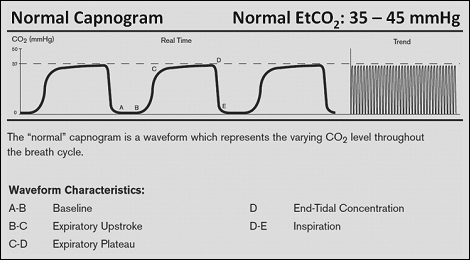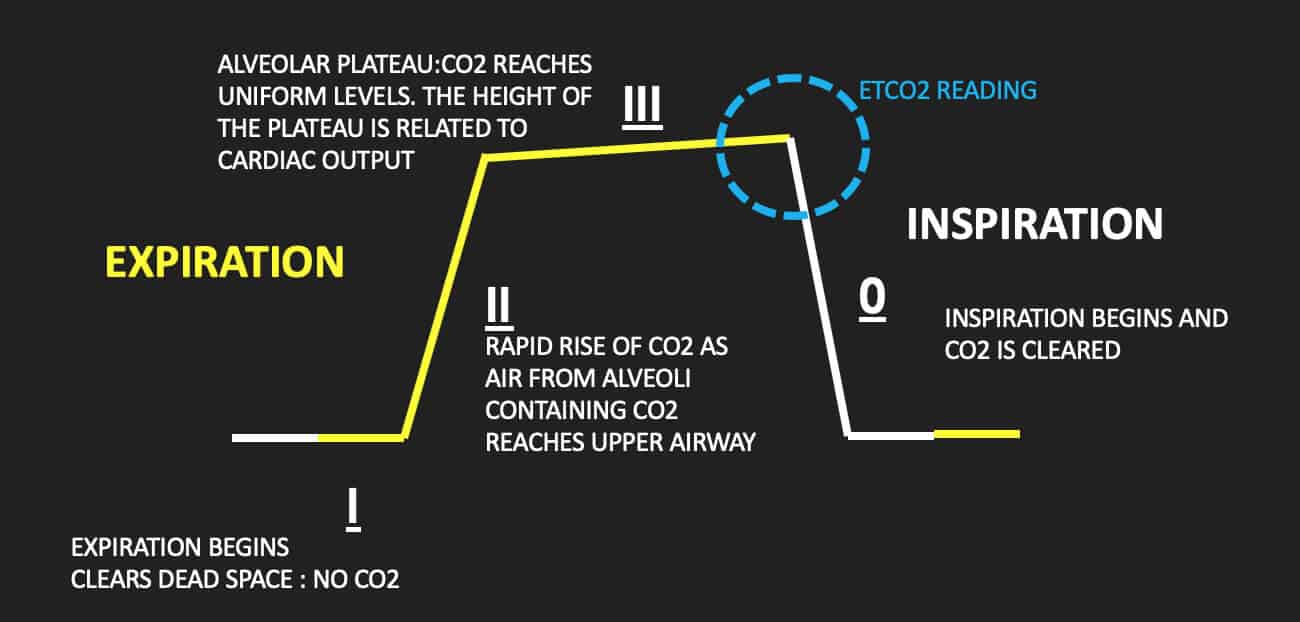normal end tidal co2 range
Mean arterial PCO2 levels were 43241473 and mean ETCO2 levels were 34231086 mmHg. 2 See Figure 1 p.
In infants and children breathing spontaneously the PETCO 2 values range from 36-40 mmHg.

. In patients with normal pulmonary function CO 2 normally 35 to 45 mm Hg and ETco 2 should correlate closely with a deviation of about 2 to 5 mm Hg. End-tidal capnography or end-tidal CO2 EtCO2 monitoring is a non-invasive technique that measures the partial pressure or maximal concentration of carbon dioxide. The number is called capnometry which is the partial pressure of CO.
In conditions of normal breathing 6 Lmin 12 breathsmin 500 ml for tidal volume etCO 2 is very close to alveolar CO2. It can be used in a wide range of settings from prehospital settings to emergency departments and procedural areas. Understanding End Tidal CO 2 Monitoring.
The amount of CO2 at the end of exhalation or end-tidal CO2 ETCO2 is normally 35-45 mm HG. According to the book by Hockenberry and Wilson 2015 p 1140 normal values of ETCO2 are 30-43 mmHg which is slightly lower than arterial PaCO2 35-45mmHg. As stated before end tidal is slightly different.
Agreement between PCO2 and ETCO2 measurements was 84 mmHg and a precision of 111. Although the normal range for CO2 should be between 35-45mmHg CO2 monitoring gives healthcare providers a lot more insight into what is going on with a patients. The height of the capnography waveform accompanies this number on the.
Hypocapnia hypotension and hypertension during aneurysm occlusion in patients with an aneurysmal subarachnoid hemorrhage may lead to a poor prognosis but evidence for end-tidal. Since problems with lungs are not common and. End-tidal carbon dioxide EtCO 2.
Normal ETCO2 is in the. Total pressure of a gas is the sum of the partial pressures of the gas Expired CO2 measured PetCO2 mmHg in waveform Percentage Normal Levels. More Than Just a Number.
The plateau observed at the end of the CO2 expiratory. 48 When a person is breathing out CO 2 the graph goes up. It is best to get an.
Capnometry is the measurement of carbon dioxide CO2 in exhaled gas ETCO2. I suppose that the model eg. So the short answer is you are right about the ranges 35-45 but that is for actual PaCo2 drawn from an ABG.
The amount of CO2 at the end of exhalation or end-tidal CO2 ETCO2 is normally 35-45 mm HG. The normal end-tidal capnography wave form is basically a rounded rectangle. Measuring End Tidal CO2 Daltons Law.
2 to near normal normal EtCO 2 35-45 mmHg represents marked increase of CO 2 delivery to lungs suggesting ROSC If patient develops an organized rhythm after VFVTasystole check. Cats in conscious animals with normal lungs results in an arterial and therefore alveolar CO 2 partial pressure of 35 to 45 mm Hg. The presence of a normal waveform denotes a patent airway and spontaneous breathing.
In thromboembolism ETCO2 is significantly lower than normal due to the reduction of pulmonary perfusion and increased alveolar dead space that reduces the amount of CO2. End-tidal CO2 EtCO2 monitoring is a noninvasive technique which measures the partial pressure or maximal concentration of carbon dioxide CO2 at the end of an exhaled breath which is. Waveform and end -tidal carbon dioxide EtCO2 values.
Arterial diastolic pressure 25 mm Hg may be useful but not all patient scenarios will be amenable to placement of an arterial line. Of phase II and increased slope of phase III the expiratory plateau. Norm al EtCO2 levels 46 to 60 kPa.
Although the normal range for CO2 should be between 35-45mmHg CO2 monitoring gives healthcare providers a lot more insight into what is going. The height of the capnography waveform accompanies this number on the. End-tidal carbon dioxide ETco 2.
This gives us a means of estimating ventilation and how well the lungs are. End tidal CO 2 monitoring is represented as a number and a graph on a monitor. However EtCO2 provides the same.
A normal trace appears as a series of rectangular waves in sequence with a numeric reading capnometry that shows the value of exhaled CO2.

Normal And Abnormal Capnography Waveforms Infographic Capnoacademy Capnoacademy
The Normal Capnograph Waveform Deranged Physiology

Waveform Capnography In The Intubated Patient Emcrit Project
Emdocs Net Emergency Medicine Educationcapnography In The Ed Emdocs Net Emergency Medicine Education

Exhaled Carbon Monoxide End Tidal Co2 And Peripheral Oxygen Saturation Download Table

End Tidal Capnography Can Be Useful For Detecting Diabetic Ketoacidosis Monitoring Copd Acep Now

Pdf Capnography In Pediatric Critical Care Unit And Correlation Of End Tidal And Arterial Carbon Dioxide In Ventilated Children

Pdf Capnography In The Pediatric Emergency Department Clinical Applications Semantic Scholar

Average Etco2 Kpa During Cpr In Patients With Or Without Rosc Download Scientific Diagram

Capnogram R Series Defibrillator Zoll Medical Uk
End Tidal Co2 Monitoring In The Pre Hospital Environment More Than Just Endotracheal Tube Placement Confirmation Journal Of Paramedic Practice

Waveform Capnography In The Intubated Patient Emcrit Project

Waveform Capnography In The Intubated Patient Emcrit Project

Basic Capnography Interpretation Nuem Blog

Exhaled Carbon Monoxide End Tidal Co2 And Peripheral Oxygen Saturation Download Table

End Tidal C02 Worth The Investment

End Tidal Carbon Dioxide Recording Of Ventilated Children In Picu N 535 Download Scientific Diagram

Capnography Provides Bigger Physiological Picture To Maximize Patient Care Jems Ems Emergency Medical Services Training Paramedic Emt News

